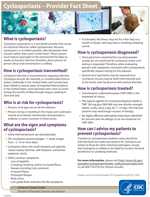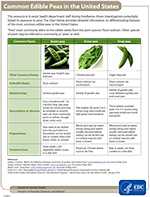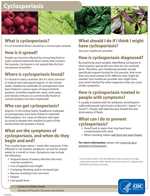Resources for Health Professionals
Surveillance & Outbreak Investigation
Description
Cyclospora infection is transmitted by ingesting infective Cyclospora oocysts (for example, in contaminated food or water). Outbreaks in the United States and Canada have been linked to various types of imported fresh produce.
Cyclospora cayetanensis completes its life cycle in humans. However, the oocysts shed in the feces of infected persons must mature (sporulate) outside the host, in the environment, to become infective for someone else. Therefore, direct person-to-person (fecal-oral) transmission of Cyclospora is unlikely. The process of maturation (sporulation) is thought to require days to weeks.

Cyclosporiasis Provider Fact Sheet
English: PDF ![]() [775 KB]
[775 KB]
Spanish: PDF ![]() [793 KB]
[793 KB]
Size: 8.5" x 11"

Common Edible Peas in the United States
English: PDF
Persons of all ages are at risk for infection. Persons living or traveling in the tropics and subtropics may be at increased risk because cyclosporiasis is endemic in some countries in these zones. In some regions, infection appears to be seasonal. But the seasonality varies in different settings and is not well understood.
Some infected persons are asymptomatic, particularly in settings where cyclosporiasis is endemic. Among symptomatic persons, the incubation period averages ~1 week (ranges from ~2-14 or more days). Cyclospora infects the small intestine and typically causes watery diarrhea, with frequent, sometimes explosive, stools. Other common symptoms include loss of appetite, weight loss, abdominal cramping/bloating, increased flatus, nausea, and prolonged fatigue. Vomiting, body aches, low-grade fever, and other flu-like symptoms may be noted. If untreated, the illness may last for a few days to a month or longer, and may follow a remitting-relapsing course. Although cyclosporiasis usually is not life threatening, reported complications have included malabsorption, cholecystitis, and Reiter's Syndrome (reactive arthritis).
On the basis of currently available information, avoiding food or water that might have been contaminated with stool is the best way to prevent infection. Travelers to cyclosporiasis-endemic areas should be told that food and water precautions for Cyclospora are similar to those for other intestinal pathogens, except that Cyclospora is unlikely to be killed by routine chemical disinfection or sanitizing methods. Symptomatic reinfection can occur.
- Page last reviewed: February 10, 2017
- Page last updated: February 10, 2017
- Content source:



 ShareCompartir
ShareCompartir